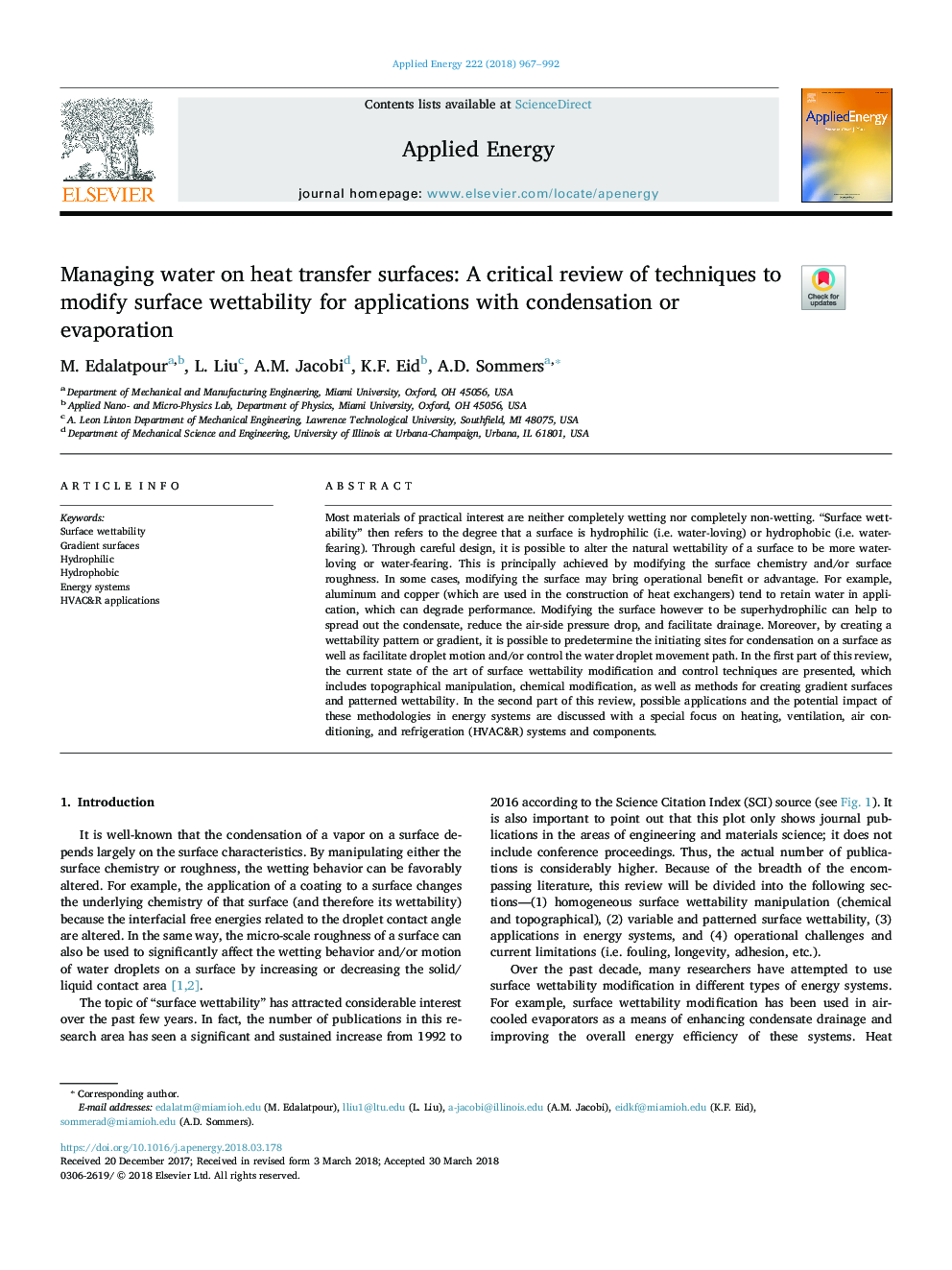| کد مقاله | کد نشریه | سال انتشار | مقاله انگلیسی | نسخه تمام متن |
|---|---|---|---|---|
| 6680202 | 1428068 | 2018 | 26 صفحه PDF | دانلود رایگان |
عنوان انگلیسی مقاله ISI
Managing water on heat transfer surfaces: A critical review of techniques to modify surface wettability for applications with condensation or evaporation
ترجمه فارسی عنوان
مدیریت آب بر روی سطوح انتقال حرارت: بازنگری انتقادی از تکنیک هایی برای اصلاح مرطوب کننده سطح برای کاربردهای با تراکم یا تبخیر
دانلود مقاله + سفارش ترجمه
دانلود مقاله ISI انگلیسی
رایگان برای ایرانیان
کلمات کلیدی
ترجمه چکیده
اکثر مواد مورد علاقه عملا نه کاملا مرطوب هستند و نه کاملا مرطوب. مرطوب کننده سطح؟ سپس به درجه ای که یک سطح هیدرولیکی (یعنی آب دوست داشتنی) یا هیدروفوب (به عنوان مثال از آب ترس) اشاره دارد. از طریق طراحی دقیق، ممکن است مرطوب بودن طبیعی یک سطح را تغییر دهید تا آب بیشتری داشته باشید یا از آب ترسید. این به طور عمده با تغییر شیمی در سطح و یا زبری سطح به دست می آید. در برخی موارد تغییر سطح ممکن است مزایای عملیاتی یا مزیت را به همراه داشته باشد. به عنوان مثال، آلومینیوم و مس (که در ساخت مبدلهای حرارتی استفاده می شوند) تمایل دارند آب را در برنامه نگه دارند، که می تواند عملکرد را کاهش دهد. اصلاح سطح با این حال می تواند سوپر هیدروفیلی باشد، می تواند به گسترش مایع تبدیل شود، افت فشار هوا را کاهش دهد و باعث تخلیه شود. علاوه بر این، با ایجاد یک الگوی مرطوب یا شیب، می توان مکان های آغازین را برای تراکم در یک سطح و همچنین حرکت قطره و / یا کنترل حرکت قطره آب را پیش بینی کرد. در بخش اول این بازبینی، وضعیت فعلی هنر اصلاح رطوبت سطح و تکنیک های کنترل ارائه شده است که شامل دستکاری توپوگرافی، اصلاح شیمیایی و همچنین روش های ایجاد سطوح شیبدار و قابلیت رطوبت الگو است. در قسمت دوم این بررسی، برنامه های کاربردی احتمالی و تاثیر بالقوه این روش ها در سیستم های انرژی با تمرکز ویژه بر سیستم های گرمایشی، تهویه، تهویه مطبوع و سیستم های تهویه مطبوع و سیستم های تهویه مطبوع مورد بحث قرار می گیرد.
موضوعات مرتبط
مهندسی و علوم پایه
مهندسی انرژی
مهندسی انرژی و فناوری های برق
چکیده انگلیسی
Most materials of practical interest are neither completely wetting nor completely non-wetting. “Surface wettability” then refers to the degree that a surface is hydrophilic (i.e. water-loving) or hydrophobic (i.e. water-fearing). Through careful design, it is possible to alter the natural wettability of a surface to be more water-loving or water-fearing. This is principally achieved by modifying the surface chemistry and/or surface roughness. In some cases, modifying the surface may bring operational benefit or advantage. For example, aluminum and copper (which are used in the construction of heat exchangers) tend to retain water in application, which can degrade performance. Modifying the surface however to be superhydrophilic can help to spread out the condensate, reduce the air-side pressure drop, and facilitate drainage. Moreover, by creating a wettability pattern or gradient, it is possible to predetermine the initiating sites for condensation on a surface as well as facilitate droplet motion and/or control the water droplet movement path. In the first part of this review, the current state of the art of surface wettability modification and control techniques are presented, which includes topographical manipulation, chemical modification, as well as methods for creating gradient surfaces and patterned wettability. In the second part of this review, possible applications and the potential impact of these methodologies in energy systems are discussed with a special focus on heating, ventilation, air conditioning, and refrigeration (HVAC&R) systems and components.
ناشر
Database: Elsevier - ScienceDirect (ساینس دایرکت)
Journal: Applied Energy - Volume 222, 15 July 2018, Pages 967-992
Journal: Applied Energy - Volume 222, 15 July 2018, Pages 967-992
نویسندگان
M. Edalatpour, L. Liu, A.M. Jacobi, K.F. Eid, A.D. Sommers,
